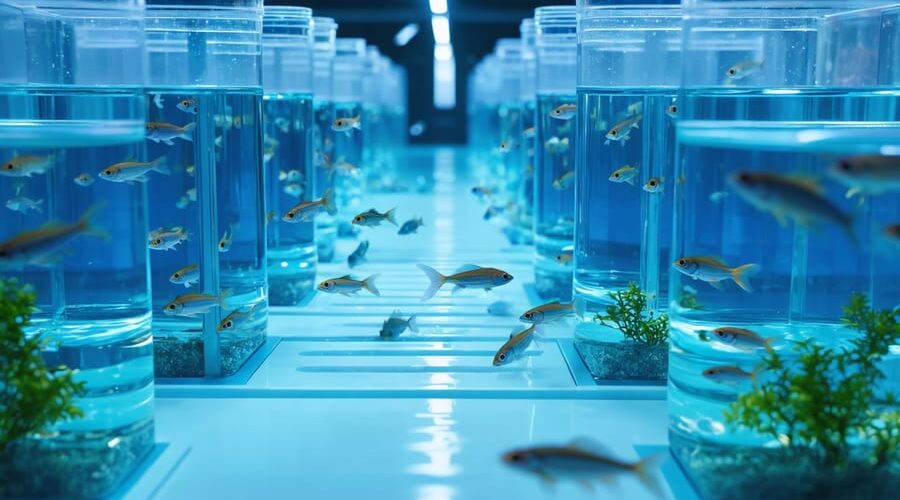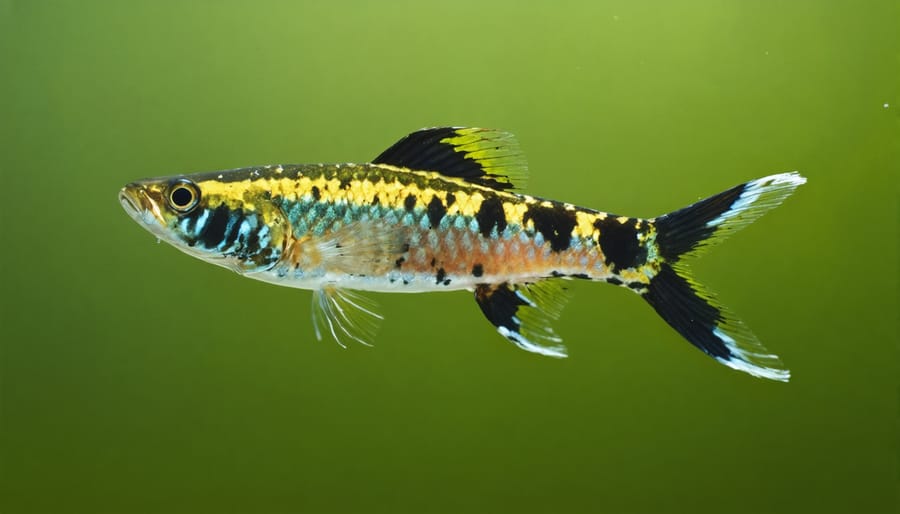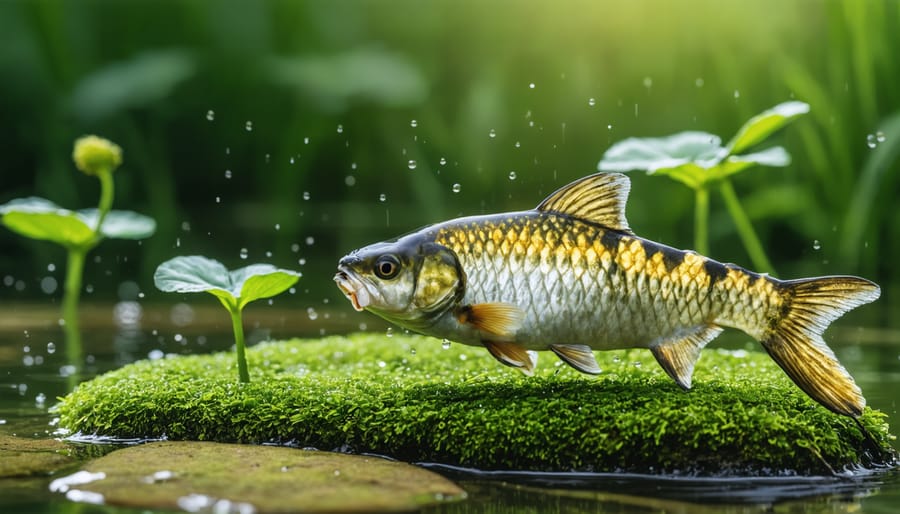
Why Scientists Trust Zebrafish Research Centers (And What Your Pond Can Learn From Them)
Deep in the hills of Eugene, Oregon, a remarkable facility houses over 60,000 zebrafish—tiny striped swimmers that have revolutionized how scientists understand everything from human disease to water quality. The Zebrafish International Resource Center (ZIRC) isn’t just a fish collection; it’s the world’s premier living library of zebrafish genetics, supporting breakthrough research at universities and labs across the globe.
But here’s what makes this fascinating for us pond enthusiasts: these transparent fish share the same basic needs as the creatures in your backyard water garden. Understanding how ZIRC maintains pristine conditions for thousands of fish tanks offers invaluable lessons for managing your own pond ecosystem.
ZIRC’s mission centers on breeding, housing, and distributing specific zebrafish strains to researchers studying genetics, development, and disease. Think of it as a seed bank, but for fish with documented genetic backgrounds. Scientists rely on these standardized fish to ensure their experiments are repeatable and reliable.
What’s truly inspiring is how ZIRC’s dedication to water quality, temperature control, and fish health mirrors the challenges you face in your pond—just on a massive, scientific scale. Their expertise in maintaining thriving aquatic environments translates directly to practical wisdom you can apply at home. Whether you’re troubleshooting cloudy water, managing fish populations, or creating the perfect habitat, the principles guiding this world-class facility can transform your pond-keeping success.
What Makes the Zebrafish International Resource Center Special
Imagine a library, but instead of books, the shelves hold thousands of living zebrafish lines, each one carefully maintained and documented. That’s essentially what the Zebrafish International Resource Center does. Located at the University of Oregon, ZIRC serves as the world’s largest public repository of zebrafish, housing over 60,000 individual fish representing more than 7,000 distinct genetic lines.
But why should you, as a pond enthusiast, care about a scientific fish facility? Here’s the connection: ZIRC isn’t just storing fish—they’re mastering the art of keeping them healthy, breeding them successfully, and preventing disease. The techniques and knowledge they’ve developed over decades translate directly to better care practices for your backyard water feature.
Think of ZIRC as the ultimate fish health resource. Their team monitors water quality constantly, understands fish behavior patterns, and can spot illness before it becomes a problem. They’ve perfected quarantine procedures, breeding protocols, and feeding schedules. These aren’t just laboratory practices—they’re principles that apply whether you’re managing a research facility or a 500-gallon koi pond in your backyard.
What makes ZIRC particularly special is their commitment to sharing knowledge. They don’t just keep fish; they educate researchers worldwide about best practices in fish husbandry. This emphasis on proper care and disease prevention creates a foundation that benefits all fish keepers. When you understand the professional standards used at facilities like ZIRC, you can adapt those principles to create a healthier environment for your own pond fish, leading to longer-lived, more vibrant inhabitants in your water garden.

Interactive Learning: How Fish Identification Workshops Work
What You Actually Do in These Workshops
These workshops aren’t your typical lecture-hall snoozefests! You’ll spend most of your time actually *doing* things with fish. Think of it as a fun, interactive learning experience where you get up close and personal with your aquatic friends.
First, you’ll learn visual identification techniques using live specimens—examining body shapes, fin patterns, coloration, and unique markings that distinguish different species. You’ll practice using identification keys (basically handy charts that guide you step-by-step) and discover why that spotted fish in your pond might actually be three different species depending on subtle details.
The hands-on fish identification workshops also include interactive activities like anatomy demonstrations, where you’ll understand what makes fish tick—from gill function to digestive systems. You might observe breeding behaviors, learn proper handling techniques (goodbye, slippery escapes!), and even practice basic health assessments.
Many workshops incorporate microscope work, letting you peek at scales and tissues up close—it’s surprisingly fascinating! You’ll walk away with practical skills for identifying and monitoring the fish population in your own backyard pond.

Why Hands-On Learning Beats Reading Alone
Have you ever tried identifying fish in your pond by flipping through a guidebook? You’re squinting at tiny printed photos, trying to match them to the fish darting around your water garden, and somehow every species starts looking the same. I’ve been there, and it’s frustrating!
This is exactly why hands-on learning makes such a difference. When you can actually observe live fish up close, compare their features side-by-side, and ask questions in real-time, identification becomes surprisingly straightforward. You’ll notice details you’d never catch in photos—like how light reflects off scales differently, or subtle differences in fin placement that distinguish one species from another.
Think of it like learning to garden. Reading about soil types is helpful, but getting your hands dirty and feeling the texture of clay versus loam teaches you far more. The same principle applies to understanding your pond fish. Interactive workshops let you see fish behavior, learn feeding patterns, and understand what healthy versus stressed fish look like—knowledge that transforms you from a confused pond owner into a confident fish keeper who can spot problems before they become serious.
Zebrafish Secrets That’ll Help Your Pond Fish Thrive
Reading Fish Behavior Like a Scientist
Scientists at the Zebrafish International Resource Center spend hours watching fish swim, and you might be surprised how much their observation techniques can help you understand your own pond fish! Researchers track specific behaviors like swimming patterns, feeding responses, and social interactions to assess fish health. The good news? You can do the same thing in your backyard pond.
When zebrafish are stressed, they exhibit telltale signs that are remarkably similar across many fish species. Watch for erratic swimming—darting movements or staying motionless at the bottom for extended periods. Healthy, happy fish maintain smooth, purposeful movements and show curiosity about their environment. They’ll explore different pond levels and respond eagerly at feeding time.
Scientists also pay attention to color changes, which can indicate stress or illness. While your goldfish or koi won’t change as dramatically as zebrafish under laboratory lights, you’ll notice fading colors or dark stress marks appearing when something’s wrong. Clamped fins held tightly against the body signal discomfort, while relaxed, flowing fins indicate contentment.
Start your own “fish journal” this week! Spend five minutes daily observing your pond during feeding time. Note swimming patterns, color vibrancy, and social interactions. You’ll quickly establish a baseline for “normal” behavior, making it easier to spot problems early. This simple practice—borrowed directly from scientific research methods—can help you catch health issues before they become serious, keeping your aquatic friends thriving all season long.
Water Quality Standards Worth Copying
Research centers like ZIRC maintain incredibly precise water conditions to keep their fish healthy, and you can borrow their wisdom for your backyard pond! These facilities follow professional water quality standards that translate beautifully to home settings with just a few simple adjustments.
The basic parameters are surprisingly straightforward. Temperature should stay between 64-82°F for most pond fish, similar to zebrafish facilities. pH levels work best around 6.5-8.0—think of it as keeping your water neither too acidic nor too alkaline. I learned this the hard way when my pond’s pH crashed after heavy rain, and my fish became lethargic within days.
Testing is easier than you’d think! Grab an affordable liquid test kit from your local pet store. Test your water weekly at first, then monthly once everything stabilizes. You’re checking for ammonia (should be zero), nitrites (also zero), and nitrates (under 40 ppm).
Here’s where research centers really shine: they change 10-20% of their water regularly. Copy this practice! I do partial water changes every two weeks, which keeps toxins low without shocking my fish.
Add beneficial bacteria products monthly to help break down waste naturally. Install adequate filtration—aim for filters that process your entire pond volume at least once per hour. These simple steps mirror what keeps research fish thriving, making your pond a healthy haven for years to come.
Bringing the Workshop Home: Identify Your Pond Fish With Confidence
Now that you’ve learned about the fascinating world of zebrafish research, let’s bring those identification skills right to your backyard! Whether you’ve recently installed one of those gorgeous backyard pond designs or you’re working with an existing water garden, knowing exactly who’s swimming in your pond makes all the difference.
**Your Step-by-Step Identification Process**
Start by observing your fish during feeding time when they’re most active and visible near the surface. Grab your smartphone or camera—you’ll want clear photos from multiple angles. Focus on three key features: body shape, coloration patterns, and fin structure. I always keep a simple notebook by my pond to jot down observations, and trust me, it becomes a treasured record over time!
Look closely at body proportions. Goldfish tend to have rounded, egg-shaped bodies, while koi are more streamlined and torpedo-like. Check the mouth area too—koi have distinctive barbels (those whisker-like appendages) while goldfish don’t.
**Common Pond Residents You’ll Encounter**
Your pond likely hosts several familiar species. Common goldfish come in orange, white, or calico patterns. Fancy goldfish varieties like fantails and orandas have dramatic fins and unique head shapes. Koi, the showstoppers of pond keeping, display endless color combinations—from solid white (platinum) to stunning metallic patterns.
Don’t overlook smaller species! If you’ve added mosquito control, you might spot mosquitofish or even white cloud minnows, which actually share research connections with zebrafish.
**Documenting Your Aquatic Community**
Create a simple tracking system that works for you. I use a photo album on my phone with dated entries and brief notes. Record each fish’s distinctive markings—that black spot on Sunny’s tail or the unique orange patch on Goldie’s head. This helps you monitor growth, spot newcomers, and quickly identify if anyone’s missing.
Note behavioral patterns too. Who’s the first to greet you at feeding time? Which fish prefers the waterfall area? These observations deepen your connection with your pond and help you spot changes in health or social dynamics early on.

Building Your Own Fish Knowledge Library
Building your own fish knowledge library is one of the most rewarding aspects of pond keeping, and you don’t need a lab coat to get started! I’ve found that keeping a simple journal by my pond has taught me more about my fish than any textbook ever could. Start by photographing your fish regularly—early morning light works beautifully, and try shooting from different angles to capture their unique markings and colors. These photos become invaluable for tracking growth patterns, identifying health changes, and yes, showing off to fellow pond enthusiasts!
Your journal doesn’t need to be fancy. Jot down observations about feeding behaviors, seasonal changes, and any unusual activities. Over time, you’ll notice patterns that help you become a better fish keeper. I love looking back at entries from previous years to remember what worked and what didn’t.
Online resources have exploded in recent years. Join pond keeper forums, follow aquatic biology pages, and don’t overlook professional resources like ZIRC that make scientific information accessible. You can transform your water garden into an ongoing learning experience for the whole family.
Most importantly, connect with your local pond community. Visit nearby water gardens, attend pond society meetings, or start a neighborhood pond club. Sharing experiences with other pond lovers creates friendships and accelerates your learning. Someone nearby probably knows exactly how to solve that algae problem you’re wrestling with!
The rigorous research happening at facilities like the Zebrafish International Resource Center might seem worlds away from your backyard pond, but the connection is closer than you think. The same observational skills that scientists use to study zebrafish behavior, water quality, and genetic traits can transform how you care for your own aquatic ecosystem. Start keeping a simple journal about your pond—note when fish are most active, how they respond to temperature changes, or which plants they favor. Watch for patterns in water clarity, algae growth, and seasonal shifts. This kind of scientific curiosity doesn’t require fancy equipment, just patience and genuine interest in the little world you’ve created. By approaching your pond with the mindset of a researcher, you’ll spot problems earlier, celebrate small victories, and develop an intuitive understanding of your fish’s needs. Every observation brings you closer to becoming not just a pond owner, but a true steward of a thriving aquatic habitat—one who understands that great fishkeeping, whether in a lab or a garden, starts with careful attention and respect for the remarkable creatures in our care.
